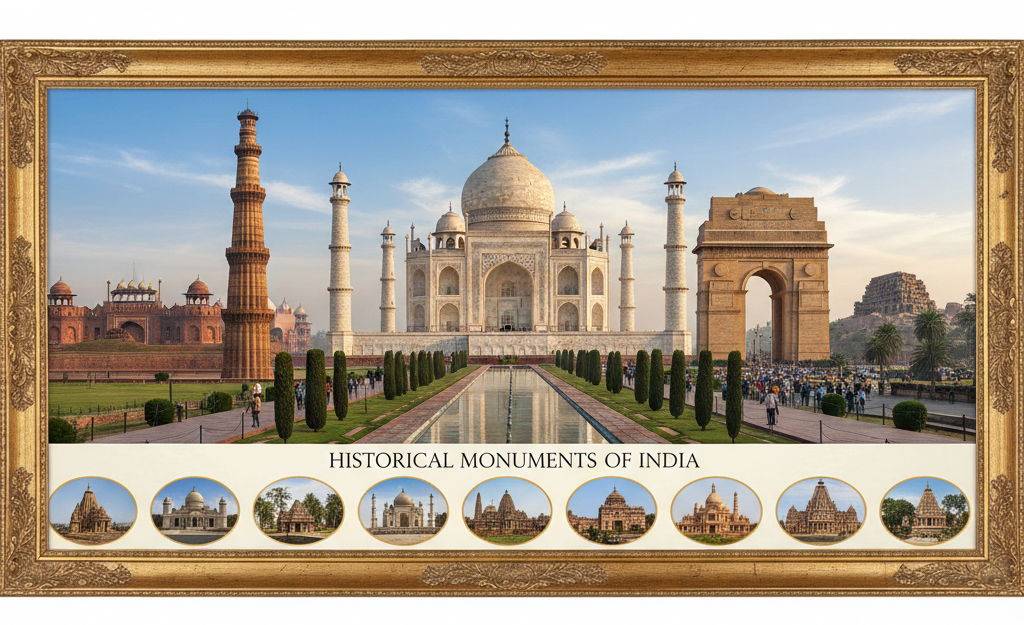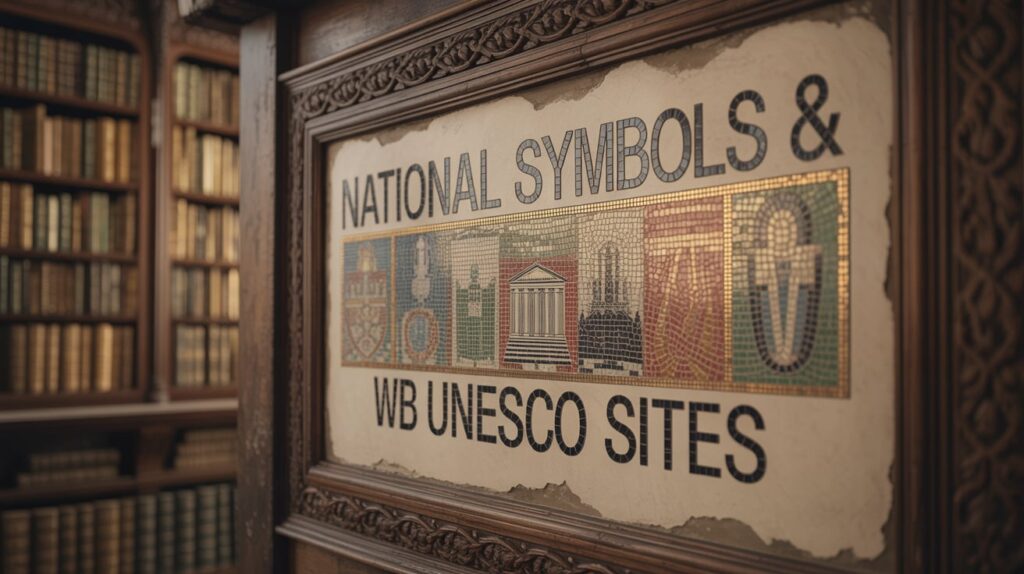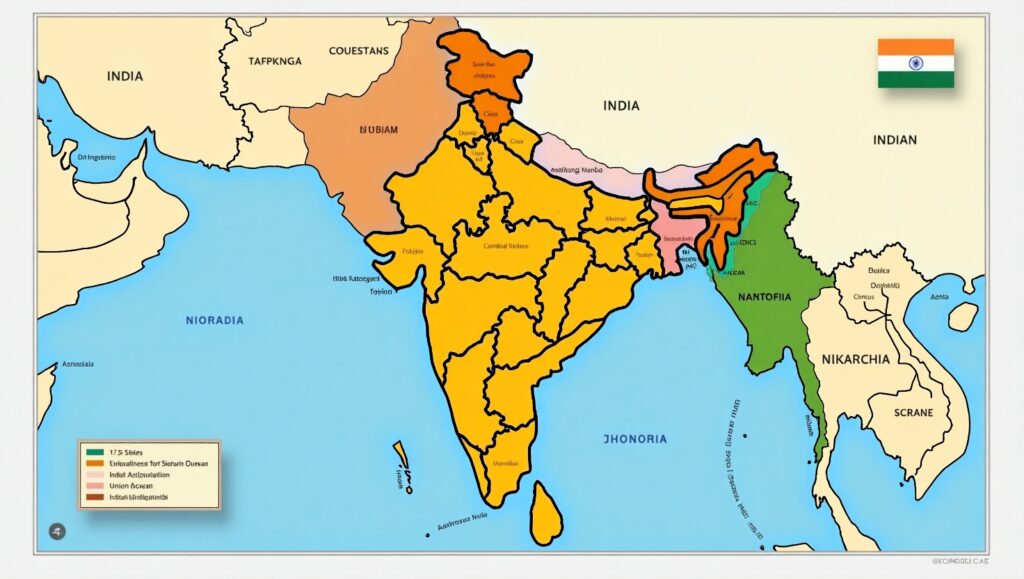Historical Monuments of India: 50 Important MCQs with Answers & Explanations
Historical Monuments of India The Historical Monuments of India represent the rich cultural, architectural, and artistic heritage of the country. From the Taj Mahal in Agra to Konark Sun Temple in Odisha and Charminar in Hyderabad, these monuments symbolize centuries of India’s glorious past. In this blog, we’ll explore 50 Multiple Choice Questions (MCQs) on the Historical Monuments of India — perfect for students preparing for competitive exams like UPSC, SSC, Banking, Railways, or State PSCs. 🏛️ Key Points on Historical Monuments of India ✅ 1. Diverse Cultural HeritageIndia is home to a vast range of architectural marvels — from ancient rock-cut caves to grand Mughal palaces — making the Historical Monuments of India a living museum of diverse traditions. ✅ 2. Reflection of Ancient DynastiesEvery structure among the Historical Monuments of India reflects the legacy of dynasties such as the Mauryas, Guptas, Mughals, Cholas, and Marathas, who contributed to India’s architectural excellence. ✅ 3. UNESCO World Heritage SitesMany Historical Monuments of India — like the Taj Mahal, Qutub Minar, Hampi, and Khajuraho — are recognized by UNESCO for their cultural and global significance. ✅ 4. Blend of Architectural StylesFrom Indo-Islamic and Dravidian to Colonial and Indo-Saracenic, the Historical Monuments of India showcase the perfect fusion of art, religion, and craftsmanship. ✅ 5. Symbol of National IdentityThe Historical Monuments of India like Red Fort, India Gate, and Cellular Jail serve as enduring symbols of patriotism, sacrifice, and the struggle for freedom. ✅ 6. Tourism and EconomyTourism driven by Historical Monuments of India contributes significantly to the national economy, drawing millions of visitors each year from across the globe. ✅ 7. Educational SignificanceStudying the Historical Monuments of India helps students understand art history, ancient engineering, and cultural development — making it a key topic for GK and UPSC exams. ✅ 8. Conservation ChallengesMany Historical Monuments of India face threats from pollution, vandalism, and neglect. Heritage conservation initiatives like “Adopt a Heritage” aim to preserve these treasures for future generations. ✅ 9. Inspiration for Modern DesignModern architecture in India often takes inspiration from Historical Monuments of India, integrating traditional motifs with contemporary design. ✅ 10. Spiritual & Cultural ImportanceTemples, mosques, churches, and monasteries among the Historical Monuments of India represent the unity in diversity of Indian civilization — celebrating art, faith, and harmony. 50 Important MCQs with Answers & Explanations 1. Which of the following monuments is known as the ‘Symbol of Eternal Love’?A) Red FortB) Taj MahalC) Qutub MinarD) Gol Gumbaz✅ Answer: B) Taj Mahal📘 Explanation: The Taj Mahal, built by Shah Jahan in memory of Mumtaz Mahal, is a UNESCO World Heritage Site and symbolizes love and beauty. 2. The Qutub Minar was built by which ruler?A) Qutub-ud-din AibakB) IltutmishC) Alauddin KhiljiD) Firoz Shah Tughlaq✅ Answer: A) Qutub-ud-din Aibak📘 Explanation: The Qutub Minar, part of the Historical Monuments of India, was started by Qutub-ud-din Aibak and completed by Iltutmish. 3. Where is the famous Konark Sun Temple located?A) Tamil NaduB) OdishaC) KarnatakaD) Gujarat✅ Answer: B) Odisha📘 Explanation: The Konark Sun Temple, a UNESCO site, represents the chariot of the Sun God and is among the most artistic monuments in India. 4. Who built the Red Fort in Delhi?A) Shah JahanB) AkbarC) AurangzebD) Humayun✅ Answer: A) Shah Jahan📘 Explanation: The Red Fort, an iconic part of the Historical Monuments of India, was built by Shah Jahan in 1648 and served as the Mughal residence. 5. The Charminar is located in which Indian city?A) HyderabadB) LucknowC) DelhiD) Mumbai✅ Answer: A) Hyderabad📘 Explanation: Built in 1591 by Muhammad Quli Qutb Shah, Charminar is a hallmark of Indo-Islamic architecture. 6. Who constructed the Gateway of India?A) British GovernmentB) East India CompanyC) Indian National CongressD) Delhi Sultanate✅ Answer: A) British Government📘 Explanation: Built in 1924 in Mumbai to welcome King George V, it’s a major colonial-era monument. 7. The Hampi ruins belong to which ancient empire?A) MauryaB) CholaC) VijayanagaraD) Gupta✅ Answer: C) Vijayanagara📘 Explanation: Hampi, part of the Historical Monuments of India, was the capital of the Vijayanagara Empire and is a UNESCO site. 8. Where is the famous Khajuraho Group of Temples located?A) RajasthanB) Madhya PradeshC) GujaratD) Maharashtra✅ Answer: B) Madhya Pradesh📘 Explanation: Khajuraho temples are famous for their intricate sculptures representing human emotions and art. 9. Sanchi Stupa is associated with which religion?A) HinduismB) BuddhismC) JainismD) Sikhism✅ Answer: B) Buddhism📘 Explanation: Built by Ashoka, the Sanchi Stupa is a Buddhist monument symbolizing the relics of Lord Buddha. 10. The Mysore Palace is the residence of which royal family?A) MarathasB) WodeyarsC) MughalsD) Peshwas✅ Answer: B) Wodeyars📘 Explanation: The Mysore Palace reflects Indo-Saracenic architecture and is a major tourist attraction in South India. 11. Who commissioned the India Gate in New Delhi?A) Lord HardingeB) Edwin LutyensC) George VD) Queen Victoria✅ Answer: A) Lord Hardinge📘 Explanation: India Gate was built in memory of soldiers who died in World War I — an iconic landmark among Historical Monuments of India. 12. Which monument in Delhi houses the tomb of Humayun?✅ Answer: Humayun’s Tomb📘 Explanation: Constructed by Hamida Banu Begum, this Mughal masterpiece inspired the architecture of the Taj Mahal. 13. Where is the Gol Gumbaz located?✅ Answer: Bijapur, Karnataka📘 Explanation: Known for its massive dome, it is the mausoleum of Muhammad Adil Shah of the Adil Shahi dynasty. 14. Ajanta and Ellora caves are found in which state?✅ Answer: Maharashtra📘 Explanation: These caves contain Buddhist, Hindu, and Jain monuments — showcasing India’s cultural unity. 15. Which fort in Rajasthan is known as the ‘Golden Fort’?✅ Answer: Jaisalmer Fort📘 Explanation: Made of yellow sandstone, Jaisalmer Fort glows golden under sunlight, hence the name. 16. The Brihadeeswarar Temple at Thanjavur was built by which Chola ruler?A) Rajendra CholaB) Raja Raja Chola IC) Karikala CholaD) Vikrama Chola✅ Answer: B) Raja Raja Chola I📘 Explanation: Among the most magnificent Historical Monuments of India, Brihadeeswarar Temple is a UNESCO World Heritage Site reflecting Dravidian architecture. 17. Fatehpur Sikri was built by which Mughal emperor?A) BaburB) AkbarC) Shah JahanD) Jahangir✅ Answer: B) Akbar📘 Explanation: Fatehpur Sikri, near Agra, was Akbar’s capital and






